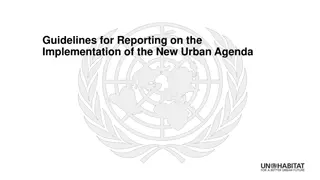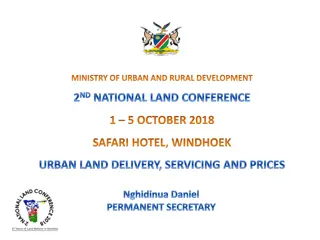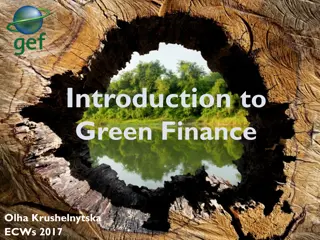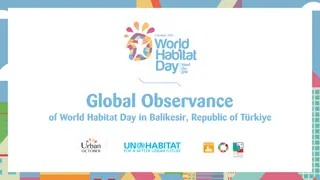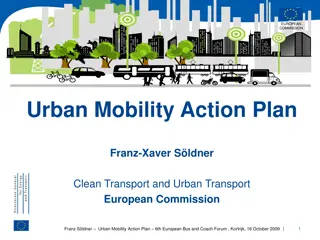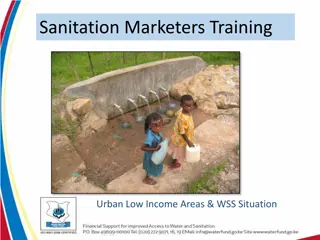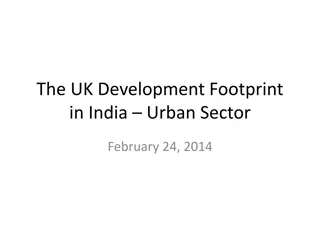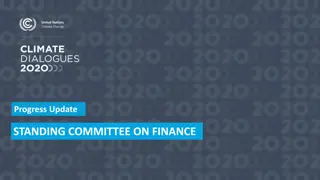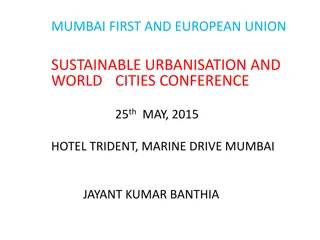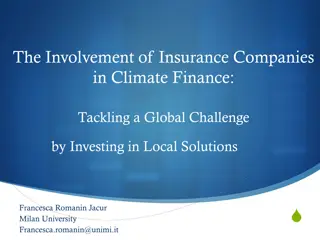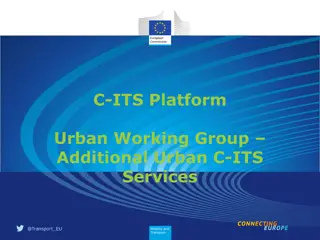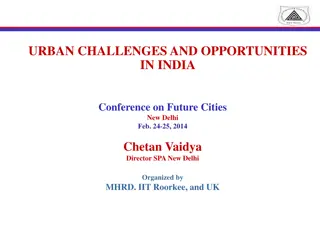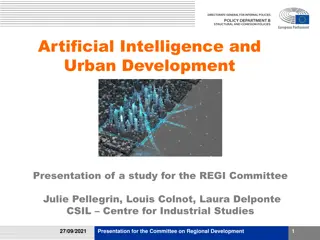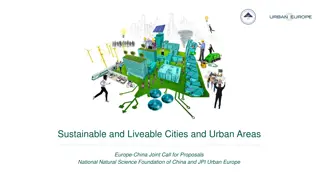
Leveraging Climate Finance for Urban Climate Actions
Financing modalities for cities' climate actions are crucial for leveraging climate and blended finance to drive sustainable urban development. Cities play a significant role in global greenhouse gas emissions, and investments in transformative urban activities can lead to substantial reductions. The rationale for climate-centric urban investments is supported by the need for paradigm shifts and transformation to address climate change effectively. Various fields for transformative actions in cities are outlined, focusing on reducing emissions, improving energy efficiency, and enhancing urban resilience.
Uploaded on | 0 Views
Download Presentation

Please find below an Image/Link to download the presentation.
The content on the website is provided AS IS for your information and personal use only. It may not be sold, licensed, or shared on other websites without obtaining consent from the author. If you encounter any issues during the download, it is possible that the publisher has removed the file from their server.
You are allowed to download the files provided on this website for personal or commercial use, subject to the condition that they are used lawfully. All files are the property of their respective owners.
The content on the website is provided AS IS for your information and personal use only. It may not be sold, licensed, or shared on other websites without obtaining consent from the author.
E N D
Presentation Transcript
Financing modalities for cities climate actions: leveraging climate and blended finance Dra en Ku an Sector Lead / Senior Urban and EE Specialist, Division Mitigation & Adaptation, GCF The 6th APEC Workshop on Sustainable Cities 9 December 2021
The APPETISER Cities and GHG emissions: INDICATIVE 80% burden of blame Average per capita GFG emissions in cities: Rotterdam 29.8 tCO2eq. Sydney 15 tCO2eq. Shanghai 12tCO2eq. Mexico City 4.25 tCO2eq. Amman 3.4 tCO2eq. Colombo 1.54 tCO2eq. Kathmandu 0.12 tCO2eq. Importance of urban economies: Both Tokyo and New York gave a greater GDP than Canada; by 2030 New Delhi will have a greater GDP than Malaysia. The IEA estimates: While currently 71% of GHG emissions; 76% of energy related GHG by 2030 will come from the cities. Caveat: Close interaction between urban form, service access and per capita GHG emissions; Low and high neighborhoods in the same city vary by a factor of 10. Density play Caveat: Scope 1: production-based emissions Scope 2: consumption-based emissions Scope 3: consumption-based emissions embodied in fuel, food, building materials and water Caveat: Focus on urban form and integrated Transportation system; Greater material, products and activities efficiency; low carbon energy / lower energy intensity
The Rationale The rationale for (climate change transformative) urban investment is based on the UNFCCC Technical Paper 13 (2014) To undertake its core mandate to foster paradigm shifts and transformation addressing climate change, the GCF needs to referring to integrated, cross-sectoral mitigation activities in urban areas, that illustrates the transformational impact: a) find ways to influence and through strong mitigation actions aimed at low-carbon, climate-resilient development at the local level across the key sectors such as buildings, transport and waste, b) where possible fundamentally alter the form and functioning of urban systems: which currently perpetuate resource-intensive and high-carbon process. cities in aggregate could reduce their GHG emissions in these core sectors by an estimated 24 per cent by 2030 and by 47 per cent by 2050 (Erickson et al., 2014) .
Transformative action fields for cities Transformative Action Fields 2030 GHG emissions reduction 2050 GHG emissions reduction Decarbonization of energy sector: renewable energy and storage 50% to 70% renewables, saving 35% - 45% of GHG At cost $40-$80 per MW Up to 90% reduction on the basis of the same trend Improving energy efficiency in building stock Buildings: 32% reduction in primary material consumption and associated GHG Buildings: 53% reduction in primary material consumption and associated GHG Mobility and transport 20% to 45% emissions reduction Same trend Urban form 20% emissions reduction 40% emission reduction combined with transportation strategies Urban resilience DRR / Optimizing value for money through resilience enablers DRR / Optimizing value for money through resilience enablers Materials and material flow 32% reduction in primary material consumption and associated GHG 53% reduction in primary material consumption and associated GHG Improving waste management 20 % reduction in related GHG emission 40% reduction in related GHG emissions
Four drivers of paradigm-shift Drivers of change across the GCF results area Transformational planning & programming Expansion and replication of knowledge Catalyzing climate Innovation Mobilization of finance at scale Increased access to of cities and city institutions to domestic and international capital markets through Support to pipeline development at scale Catalyse and participate in private sector funding vehicles eg SPVs for PPPs Targeted investments in catalytic funds, city raisings and PPP structures Support to direct access AEs (especially NDBs) in subnational climate financing Mechanisms to enhance the use of blended finance, sub-sovereign finance and mechanisms to leverage the private sector to work for cities especially in SIDS and LDCs Mobilization of national and global PIC funds through capital markets Incentivize IFIs to leverage resources and to incentivize efficiency and innovation Decarbonized & distributed Energy Developing knowledge products on business models through the Community of Practice for each TAF Utilise partnerships within CCFLA to upscale action on project development, PIC financing and NDBs Partner with other agencies & networks to maximize knowledge feedback / learning loops in each TAF sector Effectively disseminate knowledge through GCF knowledge repository and networking events Strengthen mechanisms to implement NDCs and urban climate targets through planning and programming process Foster integrated urban, transport, energy and infrastructure development Institutional strengthening for pipelining and project development Develop and apply new technical standards (MES etc) and performance standards in support of the above New business models that reduce upfront capital cost requirements and tap new revenue sources ( ex: pay-as-you-go schemes; land value capture, etc.) Support to integrated implementation of new technologies New institutions (ESCOs, etc.) New urban development models (TOD, etc.) New legislation (producer responsibility) Energy efficient buildings Paradigm - shift Green & mobility- enhanced cities pathways (Transfor mative Action Fields) Circular urban economy Compact & resilient urban form
Diagnostics urgent need for urban climate financing recalibration at global scale Central transfers / Ad hoc revenue sources Divestment pressures Decentralization pressures Local Governments National Governments Opportunities Threats Opportunities Threats Limited public finance sources Infrastructure Service Provision Resilience and DRR responsibilities Conflicting objectives Institutional capacities Limits to local fiscal capacity / appetites Governance Technical Capacities Fiscal space: land and properties Accountability Convening power Efficiencies Varying degree of Local Government s Financing Autonomy Political concentration FM Capacities Efficiencies FM / Institutional Capacities TOP-DOWN approaches - ODA financial sources - UNFCCC financial mechanisms - World Bank PPCR - National financing mechanisms Bottom-up approaches - Subnational financing - Local / community financing - Output Funding / Results Based Management approach and considerations; - Capital markets INEFFECTIVE MITIGATION & RESILIENCE FINANCING DELIVERY CONDUITS
Possible solutions.forward thinking approach to climate finance for cities Demand Capacity for structuring hybrid / catalyzing financing solutions knowledge transfer and policy support are a must; Project development vehicles; Greening of existing public finance flows; Private participation in financing; Legal and regulatory framework, including arbitration mechanism; Enhancing creditworthiness, boosting utilities credit rating and municipal revenue autonomy, fiscal and administrative capacities; On a long run, strengthen domestic capital markets Supply Facilitative financing mechanisms (municipal development funds); Incentive structures (risk mitigation and credit enhancement); Specialized financial instruments and mechanisms (pooled finance, insurance, revolving funds, municipal bonds, guarantees, viability gap subsidies and funding, etc.) Public money as a seed source (guarantees, insurance, incentives, knowledge and policy support, preparatory technical assistance, etc.) to attract and mobilize private finance with staying power through de-risking structures and transformative interventions; IMPORTANCE OF PROPER SEQUENCING OFTEN UNDERSTATED
HOW WE INVEST Through a range of financial instruments We invest through a range of financial instruments, including equity, debt, guarantees and grants Equity 2 Ordinary / Junior 1 Grants With/without repayment These can be combined into a variety of financing structures, e.g.: Project-based (SPVs) Direct equity/debt funds Fund-of-funds Structured finance vehicles On-lending 4 3 Concessional Guarantees loans Senior / Subordinated
Financial Terms and Conditions of selected GCF instruments Grants available in major convertible currencies; Grants without repayment contingencies (no reimbursement required); Grants with repayment contingency, terms adapted to the required level of concessionality of the project or programme. Concessional Loans Type of Concessional Loans Major Convertible Currency Maturity (years) Grace period (years) Annual principal repayment Years 11-20 or 6-20 (% of initial principal) Annual principal repayment Years 21-40 (% of initial principal) Interest Service fee per annum Commitment fee per annum High Any 40 10 2% 4% 0.00% 0.25% Up to 50 bps Low Any 20 5 6.7% NA 0.75% 0.50% Up to 75 bps
ROLE OF THE GREEN CLIMATE FUND De-risking & Concessionality Need for concessionality Reducing risk in a transaction; Anchoring role for co-investors to participate; Creating demand by making climate solutions affordable. Fostering behavioral changes conducive to stronger climate impacts; Instruments of concessionality Pricing concessionality Flexible guarantees Subordinated position; Fit for purpose grants to foster future climate action Flexible term & tenor Leveraging private sector, institutional investors and DFIs funding to support green growth in Developing Countries
Raising to the challenge: addressing market failures & negative externalities Human settlements are vulnerable to the increasing impacts of climate change such as extreme temperatures and sea level rise, especially in the absence of resilient infrastructure and planning; These trends are expected to grow unless actions are taken to ensure that cities and urban areas are designed to enhance productivity, resilience, and innovation, while reducing the carbon intensity of their economic and social activities. Such efforts will not only generate economic benefits, but also address market failures such as urban sprawl, congestion, and negative externalities of pollution and carbon emissions. Green Climate Fund s continuous focus of strategic considerations in the urban sector: Green vs Smart Cities; Pursuing transformative pathways in urban systems Retrofitting megacities Supporting carbon neutral / carbon negative planning, orientation and development of secondary and intermediate cities; Catalytic and innovative finance
GCF MEETING THE DEMAND AND SCALING UP TRANSFORMATIVE CLIMATE ACTION IN CITIES Compact, connected, and coordinated cities could deliver up to 3.7 GtCO2e/year of savings over the next 15 years and reduce infrastructure capital requirements by over US$3 trillion 1. GCF can offer financing opportunities for urban projects which can de- risk investments and attract private investors. 2. GCF can support a range of finance mechanisms that will leverage institutional change and linkages . 14
Selected GCF Portfolio in Cities / Selected GCF Portfolio in Cities / urban and energy efficiency sector urban and energy efficiency sector Title, Country and AE Total Financing GCF financing ADB Ulaanbaatar Green Affordable Housing and Resilient Urban Renewal Project (AHURP) Mongolia $544 million $95 million concessional loan $50 million grant ADB ASEAN Catalytic Green Finance Facility (multi country: Cambodia, Indonesia, Lao PDR, Malaysia, Thailand and the Philippines) $3.385 billion $ 280 million concessional loan $20 million grant World Bank Viet Nam: Scaling Up Energy Efficiency for Industrial Enterprises in Viet Nam $ 497 million $75 million guarantee facility $11.3 mil grant ADB Catalyzing Climate Finance (Shandong Green Development Fund) PRC $ 1.5 billion $100 million concessional loan UNDP Scaling-up Investment in Low-Carbon Public Buildings, Bosnia-Herzegovina $122 million $17.3 million grant EBRD Green Cities Facility (multi-country: Albania, Armenia, Georgia, Jordan, Moldova, Mongolia, North Macedonia, Serbia, Tunisia) Euro 600 million Euro 65 million concessional loan; Euro 22 million grant
FP082 Catalyzing Climate Finance (Shandong Green Development Fund) Part of Beijing Tianjin Hebei area Population 100 Million 3,000 km coastline Rank 8th (GDP / Capita) Highly industrialized => Representative of PRC Largest energy and coal (10%) consumer Proactive Provincial Climate Change Policies: Decarbonize the economy: Industrial Transformation Peaking CO2 emission by 2027 (3 years ahead of NDC)
FP082: GCF Investment Framework Generating pipeline bankable climate positive subprojects Screened and Assessed Six Investment Criteria <-> Baseline Transformational:H2; Green Corridor, Circular economy Advanced Benefits: Biomass; Renewable Energy, Green Procurement (EU Guidelines), Good Practices: Climate positive subprojects in line with Government Regulation
FP082: Value-addition: Catalytic Funds Shift from Business as Usual to Good Practices; Advanced Benefits and Transformational climate positive subprojects based on GCF international climate standards Selection subprojects based on: Climate mitigation/adaptation benefits (to be maximized) Bankability (to be improved) Necessary critical mass of catalytic funding: Leveraging Private Institutional Commercial (PIC) Funds > 5 Leveraging allows SGDF to enter sectors with low interest from PIC investors: Sponge Cities; Sanitation; Circular Economy SGDF investments: Targeted (climate related); Time Bound (5 to 10 y.); Transitional (refinancing by PIC after 5 to 10 years)


